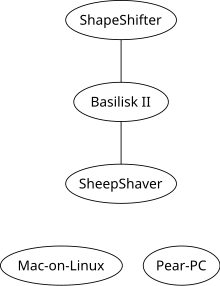PearPC
| PearPC | |
|---|---|
| Basic data
|
|
| developer | Stefan Weyergraf, Sebastian Biallas and others |
| Publishing year | May 10, 2004 |
| Current version |
0.5 ( July 13, 2011 ) |
| Current preliminary version | 0.6pre ( under development on GitHub ) |
| operating system | Windows , POSIX ( Linux / BSD / Unixoide ), BeOS |
| programming language | C ++ , assembly language |
| category | emulator |
| License | GPL ( Free Software ) |
| pearpc.sf.net | |
PearPC , also called " PowerPC Architecture Emulator "by the developers, is an emulator of a complete Power Macintosh computer on x86 computers. The name Pear ( borrowed from English , literally "[the] pear") is a play on words referring to Apple (English for "apple").
Development and technology
Most of the development took place in 2004 with the PearPC versions 0.1-0.3.1. Version 0.4.0 from December 2005 upgraded AltiVec emulation. Version 0.5.0 was not released until 2011, which creates improved compatibility with the 64-bit platform x64 , since the x86 JIT compiler can now also be used with the 64-bit instruction set extension AMD64 and Intel 64 .
PearPC either emulates a PowerPC G3 - or -G4 processor, an IDE - interface , mouse and keyboard , network cards and one PCI - Graphics card . Compatible operating systems are the PowerPC variants of Mac OS X , Darwin and various Linux versions. The emulated computer can share an internet connection of the host computer ( bridging ).
A platform-independent interpreter allows the PowerPC instruction set to be implemented on any architecture, but is very slow at a factor of approx. 500. On x86 processors , the execution speed can be increased by a factor of approximately 15 using the JIT compiler.
CherryOS
Between 2004 and 2005 there was a commercial PowerPC emulator called CherryOS , but it turned out to be a fork of PearPC with an integrated HFV Explorer . Since the GPL requires disclosure of the source text , there was a clear license violation by its developer Arben Kryeziu, who did not comply with this license agreement. CherryOS disappeared from the market at the end of 2005 .
commitment
PearPC is not suitable for productive use .
Although other PowerPC operating systems run on PearPC , including a. Darwin and Linux , the goal is unmistakably to create an emulation environment for Mac OS X. Accordingly, only Mac OS X version 10.1 “Puma” (September 2001) up to version 10.4 “Tiger” (April 2005) runs approximately stably under the emulated hardware . OpenBSD and NetBSD, for example, crash when booting because the emulation was not optimized for it. Also AIX is not running. With the integrated JIT compiler, which is still experimental with version 0.5.0 (July 2011), the emulated PowerPC guest operating system reaches around 10 percent of the speed of the host system and is therefore sufficiently fast on modern hardware.
The last Apple operating system that can run on the PowerPC architecture , Mac OS X Leopard (10.5, October 2007), can not run on PearPC due to the lack of system requirements. As of Mac OS X Snow Leopard (10.6, August 2009) the PowerPC architecture is no longer supported by Apple. As a PowerPC emulator, PearPC is therefore not suitable for newer versions of macOS (“Mac OS X” up to 2012, “OS X” up to 2016), as these only run on the x86 architecture.
See also
Web links
- Official PearPC -Projektseite on SourceForge (English)
- PearPC -Entwicklerseite the main developer Sebastian Biallas on GitHub (English)
- PearPC overview on Emaculation .com (English)
- PearPC as download at heise.de including the article from c't issue 12/2004, page 88: “Apple on pear” (via PearPC 0.1.2) by Andreas Beier
